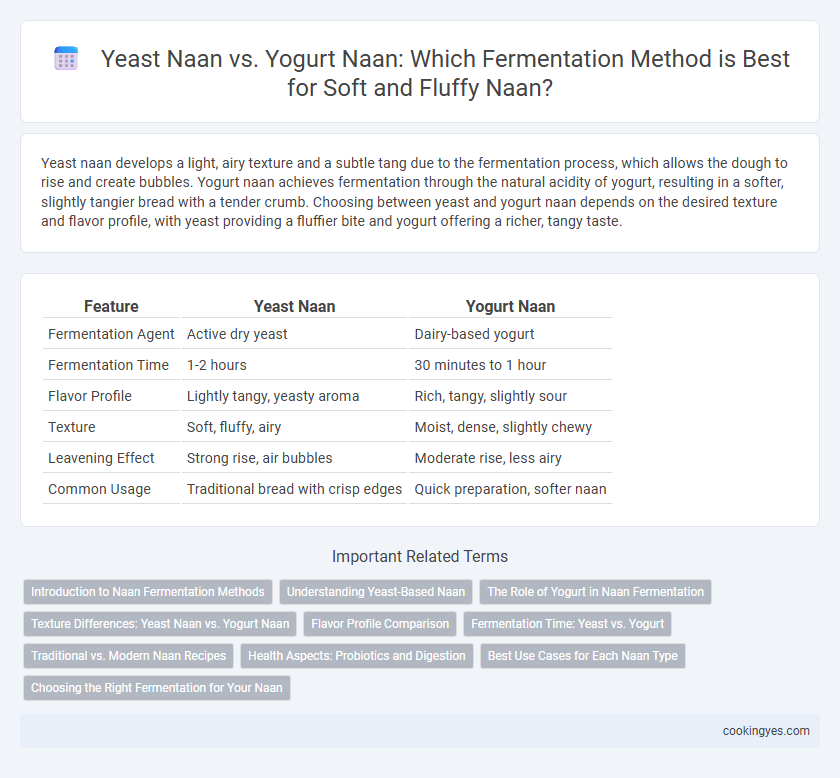Yeast naan develops a light, airy texture and a subtle tang due to the fermentation process, which allows the dough to rise and create bubbles. Yogurt naan achieves fermentation through the natural acidity of yogurt, resulting in a softer, slightly tangier bread with a tender crumb. Choosing between yeast and yogurt naan depends on the desired texture and flavor profile, with yeast providing a fluffier bite and yogurt offering a richer, tangy taste.
Table of Comparison
| Feature | Yeast Naan | Yogurt Naan |
|---|---|---|
| Fermentation Agent | Active dry yeast | Dairy-based yogurt |
| Fermentation Time | 1-2 hours | 30 minutes to 1 hour |
| Flavor Profile | Lightly tangy, yeasty aroma | Rich, tangy, slightly sour |
| Texture | Soft, fluffy, airy | Moist, dense, slightly chewy |
| Leavening Effect | Strong rise, air bubbles | Moderate rise, less airy |
| Common Usage | Traditional bread with crisp edges | Quick preparation, softer naan |
Introduction to Naan Fermentation Methods
Yeast naan utilizes Saccharomyces cerevisiae to produce carbon dioxide, creating a light and airy texture through a slower fermentation process. Yogurt naan relies on lactic acid bacteria and natural enzymes within yogurt to ferment the dough, resulting in a tangier flavor and softer crumb. Both methods influence the naan's rise and taste by altering fermentation time and microbial activity.
Understanding Yeast-Based Naan
Yeast-based naan relies on Saccharomyces cerevisiae to ferment the dough, producing carbon dioxide that creates a soft, airy texture with characteristic bubbles. The fermentation time typically ranges from 1 to 2 hours, allowing the yeast to develop flavor complexity and a slight tang. This contrasts with yogurt-based naan, where lactic acid bacteria contribute to acidity and tenderness but result in a denser crumb due to less leavening.
The Role of Yogurt in Naan Fermentation
Yogurt in naan fermentation provides natural lactic acid bacteria that enhance dough leavening and impart a tangy flavor, creating a softer texture compared to yeast naan. Unlike commercial yeast, yogurt accelerates fermentation through organic acids and enzymes, promoting a subtle sourness and improved digestibility. This natural fermentation gives yogurt naan a distinct aroma and tender crumb that is less airy but more flavorful than yeast-leavened counterparts.
Texture Differences: Yeast Naan vs. Yogurt Naan
Yeast naan develops a soft, airy texture with distinct bubbles due to the fermentation process driven by yeast, resulting in a fluffier and lighter bread compared to yogurt naan. Yogurt naan, fermented by the lactic acid bacteria in yogurt, tends to have a denser, slightly tangy crumb with a tender but less porous structure. This difference in fermentation agents significantly influences the naan's chewiness and moisture retention, making yeast naan more elastic and yogurt naan more delicate.
Flavor Profile Comparison
Yeast naan offers a slightly tangy, complex flavor due to fermentation by yeast, producing subtle bubbles and a chewy texture. Yogurt naan presents a milder, tangy taste with a softer, tender crumb because lactic acid bacteria in yogurt aid in fermentation. Comparing flavor profiles, yeast naan has a more pronounced fermentation aroma, while yogurt naan delivers a creamy richness and delicate tang.
Fermentation Time: Yeast vs. Yogurt
Yeast naan typically requires 1 to 2 hours of fermentation for optimal dough rise, resulting in a light and airy texture, while yogurt naan benefits from a shorter fermentation period of about 30 minutes to 1 hour due to the natural acidity and enzymes in yogurt that aid in quicker leavening. The lactic acid bacteria in yogurt not only speed up the fermentation process but also impart a tangy flavor and softer crumb. Yeast fermentation produces carbon dioxide gradually, allowing for a more pronounced rise and slightly chewy consistency compared to the tender, mildly sour profile of yogurt-fermented naan.
Traditional vs. Modern Naan Recipes
Traditional naan recipes often rely on yogurt for fermentation, which imparts a slightly tangy flavor and a soft, chewy texture due to lactic acid bacteria. Modern variations incorporate yeast, accelerating fermentation and creating a lighter, airier crumb with pronounced bubbles. Yogurt naan emphasizes natural fermentation and depth of flavor, while yeast naan suits faster preparation and consistent rise in contemporary kitchens.
Health Aspects: Probiotics and Digestion
Yeast naan and yogurt naan differ significantly in their fermentation processes, impacting health benefits related to probiotics and digestion. Yogurt naan undergoes lactic acid fermentation, promoting the growth of beneficial probiotics that enhance gut health and improve digestion, whereas yeast naan relies on yeast fermentation, primarily producing carbon dioxide for leavening without substantial probiotic effects. Consuming yogurt naan may support a balanced intestinal microbiome and aid in nutrient absorption, making it a healthier option for digestive wellness.
Best Use Cases for Each Naan Type
Yeast naan offers a light, airy texture ideal for dishes requiring extended fermentation, such as tandoori kebabs, where a pronounced rise enhances flavor absorption. Yogurt naan provides a tangy taste and tender crumb perfect for quick meals or pairing with rich, creamy curries like butter chicken, as its shorter fermentation retains moisture and softness. Selecting yeast naan suits slow cooking recipes needing robust bread structure, while yogurt naan excels in fast-prep settings and balanced spice combinations.
Choosing the Right Fermentation for Your Naan
Yeast naan offers a light and airy texture due to the slow fermentation process, which develops complex flavors and allows the dough to rise significantly. Yogurt naan relies on the natural acidity and enzymes in yogurt to ferment the dough quickly, resulting in a softer, tangy bread with a tender crumb. Choosing the right fermentation depends on desired texture and flavor profiles: yeast fermentation suits those seeking a fluffy, traditional naan, while yogurt fermentation appeals to fans of mildly sour, delicate flatbreads.
Yeast naan vs Yogurt naan for fermentation Infographic

 cookingyes.com
cookingyes.com